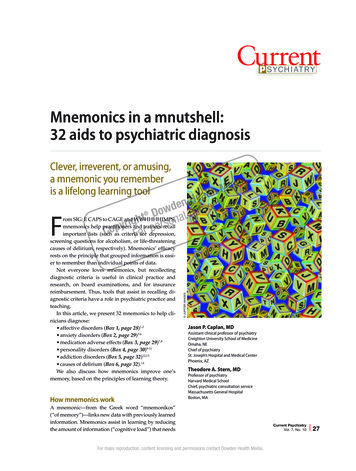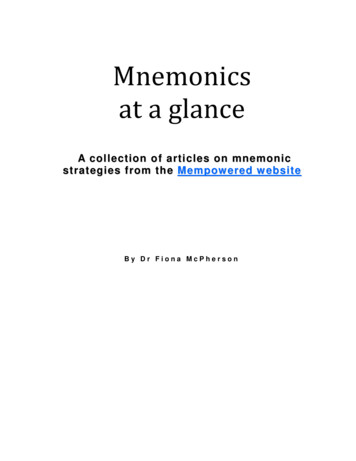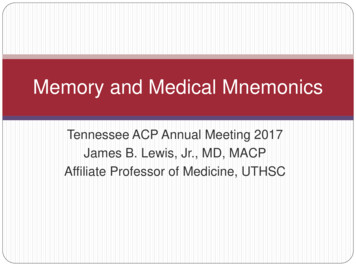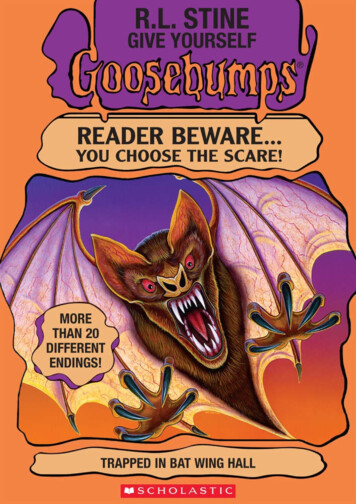
Transcription
Mnemonics in a mnutshell:32 aids to psychiatric diagnosisClever, irreverent, or amusing,a mnemonic you rememberis a lifelong learning toolea yHnenlowdse o Dultahnyrig r persopoCForom SIG: E CAPS to CAGE and WWHHHHIMPS,mnemonics help practitioners and trainees recallimportant lists (such as criteria for depression,screening questions for alcoholism, or life-threateningcauses of delirium, respectively). Mnemonics’ efficacyrests on the principle that grouped information is easier to remember than individual points of data.Not everyone loves mnemonics, but recollectingdiagnostic criteria is useful in clinical practice andresearch, on board examinations, and for insurancereimbursement. Thus, tools that assist in recalling diagnostic criteria have a role in psychiatric practice andteaching.In this article, we present 32 mnemonics to help clinicians diagnose: affective disorders (Box 1, page 28)1,2 anxiety disorders (Box 2, page 29)3-6 medication adverse effects (Box 3, page 29)7,8 personality disorders (Box 4, page 30)9-11 addiction disorders (Box 5, page 32)12,13 causes of delirium (Box 6, page 32).14We also discuss how mnemonics improve one’smemory, based on the principles of learning theory.How mnemonics work JUPITER IMAGESFiaedMhltJason P. Caplan, MDAssistant clinical professor of psychiatryCreighton University School of MedicineOmaha, NEChief of psychiatrySt. Joseph’s Hospital and Medical CenterPhoenix, AZTheodore A. Stern, MDProfessor of psychiatryHarvard Medical SchoolChief, psychiatric consultation serviceMassachusetts General HospitalBoston, MAA mnemonic—from the Greek word “mnemonikos”(“of memory”)—links new data with previously learnedinformation. Mnemonics assist in learning by reducingthe amount of information (“cognitive load”) that needsCurrent PsychiatryVol. 7, No. 1027For mass reproduction, content licensing and permissions contact Dowden Health Media.27 CPSY1008 279/12/08 3:20:58 PM
Mnemonicsto be stored for long-term processing andretrieval.15Memory, defined as the “persistence oflearning in a state that can be revealed at alater time,”16 can be divided into 2 types: declarative (a conscious recollection offacts, such as remembering a relative’sbirthday) procedural (skills-based learning, suchas riding a bicycle).Declarative memory has a consciouscomponent and may be mediated by themedial temporal lobe and cortical association structures. Procedural memory has lessof a conscious component; it may involvethe basal ganglia, cerebellum, and a varietyof cortical sensory-perceptive regions.17Declarative memory can be subdivided intoworking memory and long-term memory.With working memory, new items of information are held briefly so that encodingand eventual storage can take place.Working memory guides decisionmaking and future planning and is intricately related to attention.18-21 FunctionalMRI and positron emission tomographyas well as neurocognitive testing haveshown that working memory tasks activate the prefrontal cortex and brainregions specific to language and visuospatial memory.The hippocampus is thought to rapidlyabsorb new information, and this data isconsolidated and permanently stored viathe prefrontal cortex.22-26 Given the hippocampus’ limited storage capacity, new information (such as what you ate for breakfast3 weeks ago) will disappear if it is not repeated regularly.17BOX 1. MNEMONICS FOR DIAGNOSING AFFECTIVE DISORDERSDepressionSIG: E CAPS*Suicidal thoughtsInterests decreasedGuiltEnergy decreasedConcentration decreasedAppetite disturbance(increased or decreased)Psychomotor changes(agitation or retardation)Sleep disturbance(increased or decreased)DysthymiaHE’S 2 SAD2HopelessnessEnergy loss or fatigueSelf-esteem is low2 years minimum of depressedmood most of the day, for moredays than notSleep is increased or decreasedAppetite is increased or decreasedDecision-making or concentrationis impairedManiaDIG FASTDistractibilityIndiscretionGrandiosityFlight of ideasActivity increaseSleep deficitTalkativenessHypomaniaTAD HIGHTalkativeAttention deficitDecreased need for sleepHigh self-esteem/grandiosityIdeas that raceGoal-directed activity increasedHigh-risk activityManiaDeTeR the HIGH*DistractibilityTalkativenessReckless behaviorHyposomniaIdeas that raceGrandiosityHypersexuality* Created by Carey Gross, MDDepressionC GASP DIE1Concentration decreasedGuiltAppetiteSleep disturbancePsychomotor agitation or retardationDeath or suicide (thoughts or acts of)Interests decreasedEnergy decreased28* Created by Carey Gross, MDCurrent PsychiatryOctober 200828 CPSY1008 289/12/08 3:21:03 PM
Long-term memory, on the other hand, isencoded knowledge that is linked to factslearned in the past; it is consolidated inthe brain and can be readily retrieved.Neuroimaging studies have demonstrated opposing patterns of activation in thehippocampus and prefrontal cortex, depending on whether the memory beingrecalled is: new (high hippocampal activity, lowprefrontal cortex activity) old (low hippocampal activity, highprefrontal cortex activity).27Mnemonics are thought to affect workingmemory by reducing the introduced cognitive load and increasing the efficiency ofmemory acquisition and encoding. Theyreduce cognitive load by grouping objects into a single verbal or visual cue thatcan be introduced into working memory.Learning is optimized when the load onBOX 2. MNEMONICS FOR DIAGNOSING ANXIETY DISORDERSGeneralized anxiety disorderWorry WARTS3Wound raumatic stress disorderTRAUMA5Traumatic eventRe-experienceAvoidanceUnable to functionMonth or more of symptomsArousal increasedGeneralized anxiety disorderWATCHERS4WorryAnxietyTension in musclesConcentration difficultyHyperarousal (or irritability)Energy lossRestlessnessSleep disturbancePosttraumatic stress disorderDREAMS6Disinterest in usual activitiesRe-experienceEvent preceding symptomsAvoidanceMonth or more of symptomsSympathetic arousalClinical PointAnxiety disorder due to ageneral medicalTKconditionClinicalPointPhysical DiseasesThat HaveCommonly Appeared Anxious:TKPheochromocytomaDiabetes mellitusTemporal lobe epilepsyHyperthyroidismCarcinoidAlcohol withdrawalArrhythmiasBOX 3. MNEMONICS FOR DIAGNOSING MEDICATION ADVERSE EFFECTSAntidepressant discontinuationsyndromeFINISH7Flu-like symptomsInsomniaNauseaImbalanceSensory disturbancesHyperarousal (anxiety/agitation)Neuroleptic malignant syndromeFEVER8FeverEncephalopathyVital sign instabilityElevated WBC/CPKRigidityWBC: white blood cell countCPK: creatine phosphokinaseSerotonin syndromeHARMEDHyperthermiaAutonomic sisCurrent PsychiatryVol. 7, No. 1029 CPSY1008 29299/16/08 12:06:16 PM
Mnemonicsworking memory is minimized, enablinglong-term memory to be facilitated.28Mnemonics may use rhyme, music, orvisual cues to enhance memory. Most mnemonics used in medical practice and education are word-based, including: Acronyms—words, each letter of whichstands for a particular piece of informationto be recalled (such as RICE for treatmentof a sprained joint: rest, ice, compression,elevation). Acrostics—sentences with the first letter of each word prompting the desiredrecollection (such as “To Zanzibar by motor car” for the branches of the facial nerve:temporal, zygomatic, buccal, mandibular,cervical). Alphabetical sequences (such as ABCDEof trauma assessment: airway, breathing,circulation, disability, exposure).29An appropriate teaching tool?Dozens of mnemonics addressing psychiatric diagnosis and treatment have beenpublished, but relatively few are widelyused. Psychiatric educators may resistteaching with mnemonics, believing theymight erode a humanistic approach to patients by reducing psychopathology to “alaundry list” of symptoms and the art ofpsychiatric diagnosis to a “check-box” endeavor. Mnemonics that use humor maybe rejected as irreverent or unprofessional.30 Publishing a novel mnemonic may beviewed with disdain by some as an “easy”way of padding a curriculum vitae.Entire Web sites exist to share mnemonics for medical education (see RelatedResources, page 33). Thus it is likely thattrainees are using them with or withouttheir teachers’ supervision. Psychiatric ed-BOX 4. MNEMONICS FOR DIAGNOSING PERSONALITY DISORDERSParanoid personality disorderSUSPECT9Spousal infidelity suspectedUnforgiving (bears grudges)SuspiciousPerceives attacks (and reactsquickly)Enemy or friend? (suspectsassociates and friends)Confiding in others is fearedThreats perceived in benigneventsSchizotypal personality disorderME PECULIAR9Magical thinkingExperiences unusual perceptionsParanoid ideationEccentric behavior or appearanceConstricted or inappropriate affectUnusual thinking or speechLacks close friendsIdeas of referenceAnxiety in social situationsRule out psychotic or pervasivedevelopmental disordersBorderline personality disorderIMPULSIVE10ImpulsiveMoodinessParanoia or dissociation under stressUnstable self-imageLabile intense relationshipsSuicidal gesturesInappropriate angerVulnerability to abandonmentEmptiness (feelings of)Schizoid personality disorderDISTANT9Detached or flattened affectIndifferent to criticism or praiseSexual experiences of little interestTasks done solitarilyAbsence of close friendsNeither desires nor enjoysclose relationshipsTakes pleasure in few activitiesAntisocial personality disorderCORRUPT9Cannot conform to lawObligations ignoredReckless disregard for safetyRemorselessUnderhanded (deceitful)Planning insufficient (impulsive)Temper (irritable and aggressive)Borderline personality disorderDESPAIRER*Disturbance of identityEmotionally labileSuicidal behaviorParanoia or dissociationAbandonment (fear of)ImpulsiveRelationships unstableEmptiness (feelings of)Rage (inappropriate)* Created by Jason P. Caplan, MD30Current PsychiatryOctober 200830 CPSY1008 309/12/08 3:21:12 PM
ucators need to be aware of the mnemonicstheir trainees are using and to: screen these tools for factual errors(such as incomplete diagnostic criteria) remind trainees that although mnemonics are useful, psychiatrists should approach patients as individuals without theprejudice of a potentially pejorative label.Our methodologyIn preparing this article, we gatherednumerous mnemonics (some publishedand some novel) designed to capture thelearner’s attention and impart information pertinent to psychiatric diagnosis andtreatment. Whenever possible, we creditedeach mnemonic to its creator, but—giventhe difficulty in confirming authorship of(what in many cases has become) oral his-tory—we’ve listed some mnemonics without citation.Our list is far from complete because welikely are unaware of many mnemonics,and we have excluded some that seemedobscure, unwieldy, or redundant. We havenot excluded mnemonics that some mayview as pejorative but merely report theirexistence. Including them does not meanthat we endorse them.This article lists 32 mnemonics relatedto psychiatric diagnosis. Thus, it seemsodd that an informal survey of 60 residents at the Massachusetts General Hospital (MGH)/McLean Residency TrainingProgram in Psychiatry revealed that mostwere aware of only 2 or 3 psychiatric mnemonics, typically: SIG: E CAPS (a tool to recall the criteriafor depression)continuedHistrionic personality disorderPRAISE ME9Provocative or seductive behaviorRelationships considered moreintimate than they areAttention (need to be the center of)Influenced easilyStyle of speech (impressionistic,lacking detail)Emotions (rapidly shifting, shallow)Make up (physical appearanceused to draw attention to self)Emotions exaggeratedNarcissistic personality disorderGRANDIOSE11GrandioseRequires attentionArrogantNeed to be specialDreams of success and powerInterpersonally exploitativeOthers (unable to recognizefeelings/needs of)Sense of entitlementEnviousDependent personality disorderRELIANCE9Reassurance requiredExpressing disagreement difficultLife responsibilities assumed by othersInitiating projects difficultAlone (feels helpless anduncomfortable when alone)Nurturance (goes to excessivelengths to obtain)Companionship sought urgentlywhen a relationship endsExaggerated fears of being leftto care for selfHistrionic personality disorderACTRESSS*Appearance focusedCenter of attentionTheatricalRelationships (believed to bemore intimate than they are)Easily influencedSeductive behaviorShallow emotionsSpeech (impressionistic and vague)Avoidant personality disorderCRINGES9Criticism or rejection preoccupiesthoughts in social situationsRestraint in relationships due tofear of shameInhibited in new relationshipsNeeds to be sure of being likedbefore engaging sociallyGets around occupational activitieswith need for interpersonal contactEmbarrassment prevents newactivity or taking risksSelf viewed as unappealing or inferiorObsessive-compulsive personalitydisorderSCRIMPER*StubbornCannot discard worthless objectsRule obsessedInflexibleMiserlyPerfectionisticExcludes leisure due to devotionto workReluctant to delegate to others* Created by Jason P. Caplan, MD* Created by Jason P. Caplan, MDCurrent PsychiatryVol. 7, No. 1031 CPSY1008 31319/12/08 3:21:17 PM
Mnemonics DIG FAST (a list of criteria for diagnosing mania) WWHHHHIMPS (a tool for recallinglife-threatening causes of delirium).Although this unscientific survey maybe biased because faculty or trainees atMGH created the above 3 mnemonics,it nonetheless begs the question of whatqualities make a mnemonic memorable.Learning theory provides several clues.George Miller’s classic 1956 paper, “Themagical number seven, plus or minus two:some limits on our capacity for processinginformation,” discussed the finding that 7seems to be the upper limit of individualpieces of data that can be easily remem-bered.31 Research also has shown that recruiting the limbic system (potentiallythrough the use of humor) aids in the recallof otherwise dry, cortical information.32,33Intuitively, it would seem that nonrepeating letters would facilitate the recall ofthe linked
This article lists 32 mnemonics related to psychiatric diagnosis. Thus, it seems odd that an informal survey of 60 resi-dents at the Massachusetts General Hos-pital (MGH)/McLean Residency Training Program in Psychiatry revealed that most were aware of only 2 or 3 psychiatric mne-monics, typically: SIG: E CAPS (a tool to recall the criteria for depression) Histrionic personality disorder .











